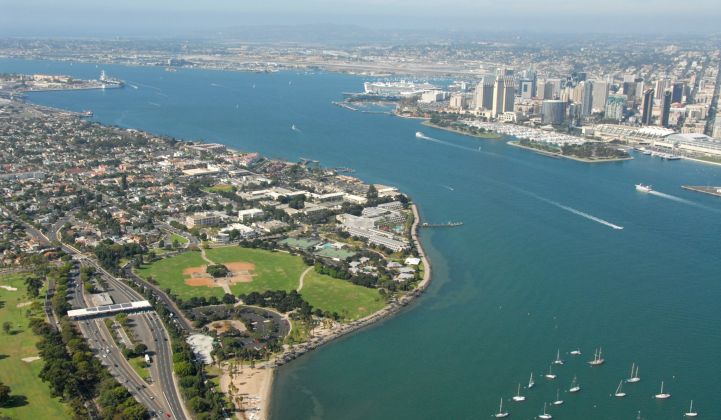San Diego Gas & Electric may have turned to a new natural-gas-fired power plant to provide most of the power it needs to replace the shuttered San Onofre nuclear power plant. But that still leaves hundreds of megawatts to give out to the preferred alternatives.
Last week, SDG&E announced the latest opportunity to help fill that gap, with a request for offers (RFO) for up to 140 megawatts of “preferred energy resources." That’s California’s term for renewable energy, distributed generation, energy efficiency and demand response, and as a tagalong, energy storage.
SDG&E is looking for a chance to rate-base some energy storage as a utility asset, but is otherwise opening the field to third parties that can meet its needs. Those include hitting the multi-hour “resource adequacy” requirements of state grid operator CAISO, as well as the ability to come on-line no later than 2022.
The utility is seeking to help fill the gap torn in the region’s grid plans by the 2012 shutdown of San Onofre, as well as the planned closure of "once-through cooling" power plants under state water regulations. Along with Southern California Edison, SDG&E was tasked with finding hundreds of megawatts of new reliable, flexible and cost-effective energy to meet its local capacity requirement needs and keep the grid stable at times of highest demand -- and get as much of it as possible without using fossil fuels.
SDG&E’s bid isn’t as big as neighboring utility Southern California Edison’s 2014 procurement, which secured more than 200 megawatts of distributed energy resources out of a 2.2-gigawatt local capacity resource (LCR) requirement. But SDG&E is securing a greater proportion of its resources from non-fossil-fuel alternatives.
Back in May, in a decision denounced by environmental and renewable energy groups, the California Public Utilities Commission (CPUC) allowed SDG&E to contract with NRG Energy for a 500-megawatt natural-gas-fired power plant in the coastal city of Carlsbad. That was reduced from the 600 megawatts SDG&E had originally sought, leaving the utility with more preferred resources to procure, GTM Research analyst Ravi Manghani said.
In late 2014, SDG&E launched its first RFO to meet this gap, seeking an undetermined amount of third-party-owned preferred resources, as well as utility- and third-party-owned energy storage, to help meet the minimum target set by the CPUC back in 2014. SDG&E took bids in January 2015, and is in the final stages of reviewing them now, Emily Shults, vice president of procurement for SDG&E, said in a Tuesday interview.
The new 140-megawatt procurement is for its 2016 LCR, but is "no different than our 2014 all-source solicitation,” she said, although it does incorporate things the utility has learned since the last round of bids. SDG&E, which is owned by Southern California Gas parent company Sempra and serves about 3.5 million customers, will hold a bidders conference on April 13 to provide more details, she added.
SDG&E has split its procurements up into “product types,” Patrick Charles, origination analytics manager, said in a Tuesday interview. Those include specific guidelines for energy efficiency, demand response, renewable resources, distributed generation, and energy storage.
“The integrated procurement approach we’re working toward is still in development,” he said -- meaning that SDG&E isn’t ready to say much about how it’s going to weigh the relative merits of different proposals, using different technologies to meet different grid needs. Nor has it supplied any guidance on what share of different resource types it will be seeking, or at what cost.
SDG&E’s RFO will consider proposed projects based on their loading order ranking, or how they stand in the state-mandated chain of best-to-worst clean energy alternatives. It will also consider Category 1 flexible resource adequacy (RA), or the capability of providing capacity during two 3-hour periods per day.
SDG&E's energy storage RFO differs from the rest, as it’s the only one that contemplates utility-owned assets. The offer falls into three categories. The first two are simple -- the Energy Storage System Power Purchase Tolling Agreement, owned by someone else and built on their land, and the Energy Storage System Turnkey Build, Own, Transfer Agreement, built with the option for SDG&E to “acquire the [storage] project from the...developer upon project completion.”
The third version, called Energy Storage System Turnkey Engineering, Procurement and Construction Agreement, is built by a third party on SDG&E land. This is a relatively new model, although Southern California Edison has also been experimenting with it in pilot projects.
SDG&E is already providing one-third of its electricity from renewable resources, with some 60 green energy projects generating about 2,400 megawatts. It gets even more from its net-metered rooftop PV customers, and is expected to be the first investor-owned utility in California to reach its net metering caps, pushing it into new “NEM 2.0” territory. And it is deep into pilot projects to incorporate electric vehicles, behind-the-meter energy storage, and flexible demand-side resources.



